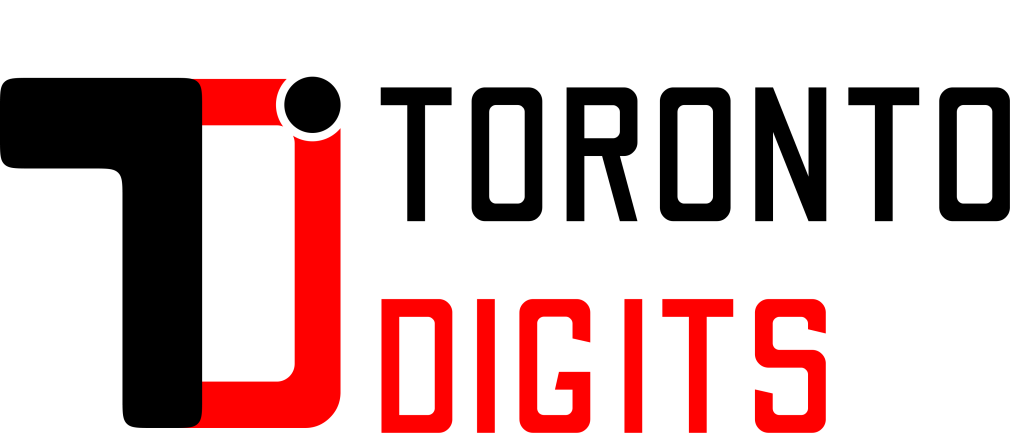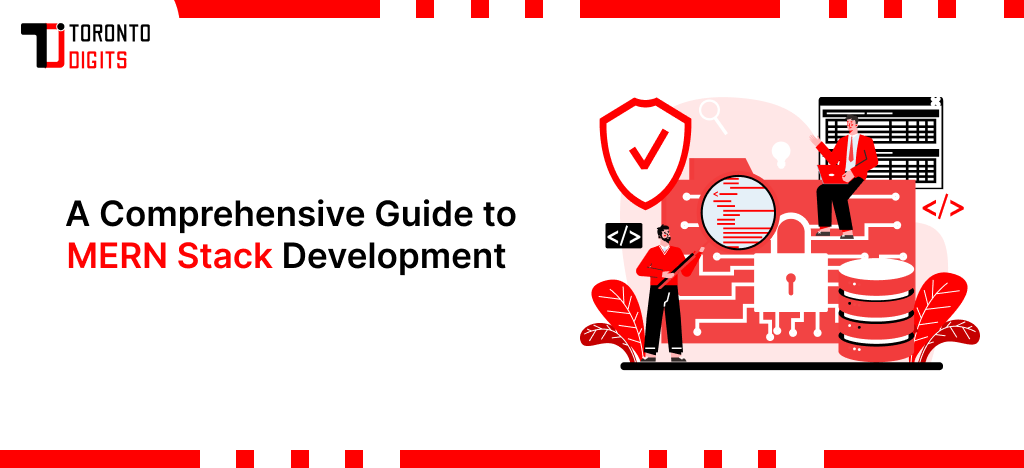The MERN stack is a popular JavaScript-based framework for building full-stack web applications. It comprises MongoDB, Express.js, React, and Node.js as its core components.
MERN offers a streamlined workflow and easy scalability by using JavaScript across frontend and backend codebases. Its flexibility makes it suitable for developing anything from simple websites to large-scale enterprise applications.
Let’s learn about the components of the MERN stack and how to utilize them for full-stack development.
The MERN Stack refers to a set of technologies used in web development.
MERN stack represents the first letter of each technology used.
- MongoDB is a document-based NoSQL database used for storing application data.
- Express.js is a backend web application framework that runs on Node.js.
- React is a JavaScript front-end library for building user interfaces.
- Node.js is an open-source JavaScript runtime environment used for executing server-side code.
Together, these technologies provide a lightweight and efficient framework for end-to-end web application development, including data management and UI rendering.
Why Use the MERN Stack?
Some key advantages of using the MERN stack over other web development stacks include:
- JavaScript everywhere: MERN utilizes JavaScript throughout the entire codebase, eliminating the need to switch between multiple languages.
- Speed and Performance: Node.js and React offer excellent performance, resulting in smooth app experiences.
- Scalability: The modular nature of MERN makes it easy to scale apps according to traffic demands.
- MongoDB’s schema-less approach allows for flexibility in adapting to evolving data requirements during agile development.
- Easy Deployment: MERN apps can be easily deployed on various cloud hosting services, such as AWS and Azure.
- Active community: As an open-source framework, MERN benefits from a vibrant ecosystem of libraries, tools, and developers.
The synergies among MERN technologies enable efficient and rapid application development. MERN is emerging as the go-to framework for modern web development, from prototyping MVPs to delivering enterprise-scale applications.
Understanding the Components of the MERN Stack
Now, let’s explore the building blocks of MERN in more depth.
MongoDB
MongoDB is a document-oriented NoSQL database that stores data in flexible, JSON-like documents with dynamic schemas. This simplifies the storage and querying of unstructured or polymorphic data for developers compared to relational databases.
MongoDB is designed for scalability, performance, and high availability. Its distributed architecture across servers provides redundancy and failover, while horizontal scaling handles increased traffic loads. Popular features such as indexing, aggregation, and ad-hoc querying provide speed and power to application backends.
Express.js
Express.js is a fast and minimalist web application framework that runs on top of Node.js. It simplifies backend web development by handling routine tasks such as server configuration, endpoint routing, request handling, and authentication.
With Express.js, developers can quickly create robust APIs and web servers by connecting reusable middleware functions. Templating engines, session management, and URL routing are features that provide organization and structure for web applications. Easy integration with MongoDB makes it a popular framework for handling server-side MERN tasks.
React
React is an open-source JavaScript library for developing interactive user interfaces, created by Facebook. It is based on components that manage their state and rendering, enabling the construction of complex user interfaces (UIs) using encapsulated building blocks.
React’s virtual DOM algorithm detects changes in UI components and minimizes DOM manipulation for optimal performance. Features such as reusable components, declarative JSX syntax, and state management make React a top choice for front-end web development today.
Node.js
Node.js is a cross-platform JavaScript runtime environment built on Chrome’s V8 engine. It allows the execution of JavaScript code outside of a web browser. Node.js enables the use of JavaScript for server-side scripting and running backend processes.
Asynchronous, event-driven architecture makes Node.js lightweight and efficient for real-time applications. An extensive ecosystem of open-source Node.js libraries simplifies the process of building scalable network applications. Node.js is commonly used in conjunction with Express.js in the MERN stack to handle the backend application logic.
MERN Stack Architecture
The MERN stack follows the classic three-tier architectural pattern: the frontend UI layer, backend API layer, and database layer. Let’s examine each tier:
The UI Layer
This layer powers the user interface of the application. In a MERN stack app, React is responsible for running this layer. React components define reusable UI elements that can be composed to build complex interfaces. For example, individual components can be created for the header, content, footer, etc.
React’s component-based architecture promotes modularity and reusability in UI development. Additionally, its declarative nature abstracts the logic of manipulating the DOM. This makes building user interfaces (UIs) intuitive and efficient.
The API Layer
This middle layer handles server-side logic and integrates the front-end and back-end services. Express runs this layer in a MERN (MongoDB, Express, React, Node.js) application.
Express provides easy routing and middleware capabilities to build robust APIs. Routes handle incoming API requests, while middleware processes and prepares data before sending it to the client.
Developers can utilize Express to build scalable REST APIs that interact with the database and provide dynamic data to the React-based UI.
The Database Layer
This layer persists and organizes data using MongoDB. MongoDB is a document database that stores data in JSON-like documents, which can vary in structure. This flexibility makes it easy to evolve data models over time.
MongoDB is highly scalable and also provides high availability. Features such as replication and sharding enable MongoDB to scale horizontally across multiple servers.
By utilizing MongoDB’s expressive query language, Express APIs can retrieve and manipulate data to dynamically enhance UI experiences on the front end.
MERN Stack Development
Now that we understand the MERN architecture, let’s go through a sample workflow for building a MERN application from scratch.
How to Set Up the Development Environment?
- First, we need to install and configure the various MERN technologies.
- To run JavaScript outside the browser, you need to install Node.js and npm.
- To start the database server, you must install MongoDB and then run the Mongod process.
- Create a new Node.js project and initialize a package.json file.
- Install Express, React, and the necessary libraries, such as react-dom and mongoose, using npm.
Additionally, a code editor such as VSCode, along with linting tools like ESLint, helps streamline the development process.
Building a Basic MERN App
With the environment set up, we can start building our app, component by component.
Set up an Express server by initializing the Express app instance. Configure middleware, routes, and APIs, and integrate MongoDB using the Mongoose Object Data Modeling (ODM) framework.
- Create React components – Develop reusable components such as a header, footer, and content. Compose these components in App.js (the root component).
- Fetch Data from API – Utilize React hooks, such as useEffect, to make calls to Express APIs from React and retrieve data.
- Manage state – Utilize the useState hook to handle UI state in components. Update the state when data is received.
- Routing: Set up routing on the client side using React Router to manage page navigation.
- Styled Components – Utilize libraries like Styled Components to style React UI elements.
Gradually combining these pieces will result in a basic, functioning MERN application.
MERN Stack Performance and Scalability
While functionality is essential, we also need to optimize our MERN (MongoDB, Express, React, Node.js) apps for performance and scalability. Let’s explore some best practices.
Optimizing Performance
- Lazy loading – Load non-critical React components and data lazily to speed up the initial load.
- Code splitting – Splitting bundles to download only the necessary code for each page.
- Caching – Cache expensive computations and API calls that do not change frequently.
- Compression – Gzip compresses assets and enables compression middleware in Express.
- Minification – Minify React components, CSS, and JS bundles to reduce payload size.
Scaling the App
- Horizontal Scaling – Scale MongoDB and Node.js across multiple servers to handle high loads.
- Load balancing – Utilize a load balancer to evenly distribute traffic among Node.js instances.
- Database Indexing – Add appropriate indexes to MongoDB collections to enhance query performance.
- Caching – Implementing caches, such as Redis, to offload non-critical data from the database.
MERN Stack Security
Since web apps handle sensitive data and connect to remote services, implementing robust security measures is crucial. Some best practices include:
- Use Mongoose schemas and model validation to sanitize data before storing it.
- Hash and salt passwords before storing them in MongoDB.
- Use Express middleware, such as Helmet and Cors, to configure security HTTP headers.
- Use JWT-based authentication to protect routes and verify users.
- Only expose necessary API endpoints and disable unused ones.
- Prevent NoSQL injections by using Mongoose.
- Implement reCAPTCHA on signup and login forms to prevent bots.
Additionally, tools like Snyk can be used to continuously scan dependencies for vulnerabilities. Monitoring systems, such as Sentry, can also be implemented to detect suspicious activity.
Advanced MERN Stack Terms
As MERN apps grow in scope, leveraging additional techniques can help manage complexity.
State Management
For complex user interfaces (UIs) that involve substantial client-side logic, it is recommended to integrate dedicated state management using Redux. This will isolate state handling from components.
Routing
Use React Router’s dynamic routing and nested routes to navigate efficiently between components.
Code Reuse
Create reusable utility functions to eliminate redundant logic throughout the application. Additionally, create custom React hooks to reuse stateful logic.
Testing
Implement unit and integration tests using Jest and React Testing Library. Write end-to-end tests using Cypress.
CI/CD Pipelines
Automate builds, testing, and deployments by setting up continuous integration and continuous deployment (CI/CD) pipelines using tools like GitHub Actions.
Monitoring
Incorporate logging using tools such as Winston, and monitor applications using New Relic and Sentry.
Conclusion
The MERN stack provides a robust set of technologies for building full-stack JavaScript web applications. With its modular architecture, MERN empowers developers to build fast and scalable applications using standardized tools.
However, let me remind you that while the MERN stack is well-suited for many use cases, it is important to select the appropriate tools based on the specific needs of the project. For example, Next.js may be preferable for server-side rendered React apps, while Python/Django is better suited for apps that require advanced ORM capabilities.
By making informed technology choices and adhering to best practices for performance, scalability, and security, developers can effectively build production-ready MERN applications.
Learn more about our MERN Stack services.




